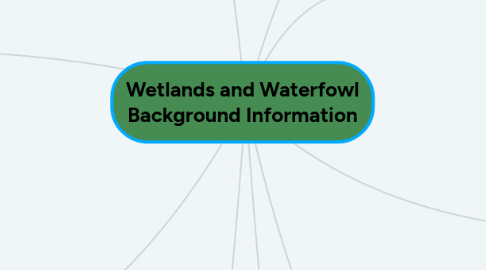
1. Introdution
1.1. Wetlands and Waterfowl depend on each other in the wild. The Waterfowl get food and camouflage from the Wetlands and in return the birds keep the Wetlands vegetation down. The Wetlands help humans an well, they keep the floods down, filter out pollutants and many other things.
2. Major Wetland Types
2.1. Bogs
2.1.1. Bogs are made when decaying plants fill up a lake. It has a spongy ground with frogs, amphibians, and the rare spotted turtle. Their flora ranges from tall black spruce trees to tiny flowers like the Labrador tea.
2.2. Marshes
2.2.1. Marshes have about an inch to several feet deep of standing water, although the water levers change year after year. They have a variety of plants, which is how they got the nick name flooded grasslands, some of the plants are lily pads, cattails, arrowhead, and elodea. Marshes also have many animals, such as cranes, marsh wren, muskrats, beaver, and otter. They also have sand dunes.
2.3. Swamps
2.3.1. Unlike marshes swamps have mainly woody plants and the ground is waterlogged through out the season. They are basically flooded woodlands with ash trees, elm trees and dogwood trees on the watery landscape. They have ducks, frogs, salamanders, water shrews, and barred owls.
3. Why are Wetlands Important?
3.1. A few extra things Wetlands do
3.1.1. Wetlands filter pollutants surface runoff, traps fertilizers, pesticides, and sediments. They also reduce flooding by absorbing the rain and then slowly releasing the water in to lakes and streams nearby.
3.2. Michigan contributes about 2300 different plant species 50% of these are in Wetlands, and 25% of that are endangered or threatened. Wetland also have more than 40% of the 575 vertebrate that live in Michigan live in or use the Wetlands.
4. What are the threats to Wetlands
4.1. The main threat to Wetlands is creation, maintenance, and transformation of the Wetland habitat.
5. History
5.1. When the Ice age in Michigan was coming to an end, the glaciers started melting and formed kettle lakes, some of which turned into bogs. While Native Americans knew how to use the glacial water when the Europeans arrived they saw only problems with the bogs and drained them.
6. Wetland regulations
6.1. Laws now protect the Wetlands by having laws against alterations like draining or polluting the Wetlands.
7. Annual Cycles and Seasonal Needs
7.1. Waterfowl go through cycles every year, they will bond with their mate, migrate, breed, rest, molt then migrate again.
8. Life Cycle of Three Common Waterfowl
8.1. Wood Ducks
8.1.1. Wood ducks arrive at Michigan in March to begin the laying cycle. The first scout out a tree close to the water, although it can be up to a mile away. Next the lay the eggs, each clutch is around 12 eggs. The baby birds and hen move around nesting cites in the Wetlands.
8.2. Mallards
8.2.1. Female mallards like to lay their eggs in grassy areas like hay fields. the Eggs are typically lain 500 feet from the water, but can also be up to a mile away. The hen lays one egg every day up to 9-10 days, she will then sit on them until they hatch( in 25 days).
8.3. Blue Winged Teal
8.3.1. Blue Winged Teals like to nest in seasonally or temporarily flooded areas later in the season. She lays up to 10 eggs per clutch. The hen feeds in less than 8 inches water, eating mainly seeds, crustaceans and snails.Being a late nesters when the duckling hatch the seasonal Wetlands are normally unavailable.

